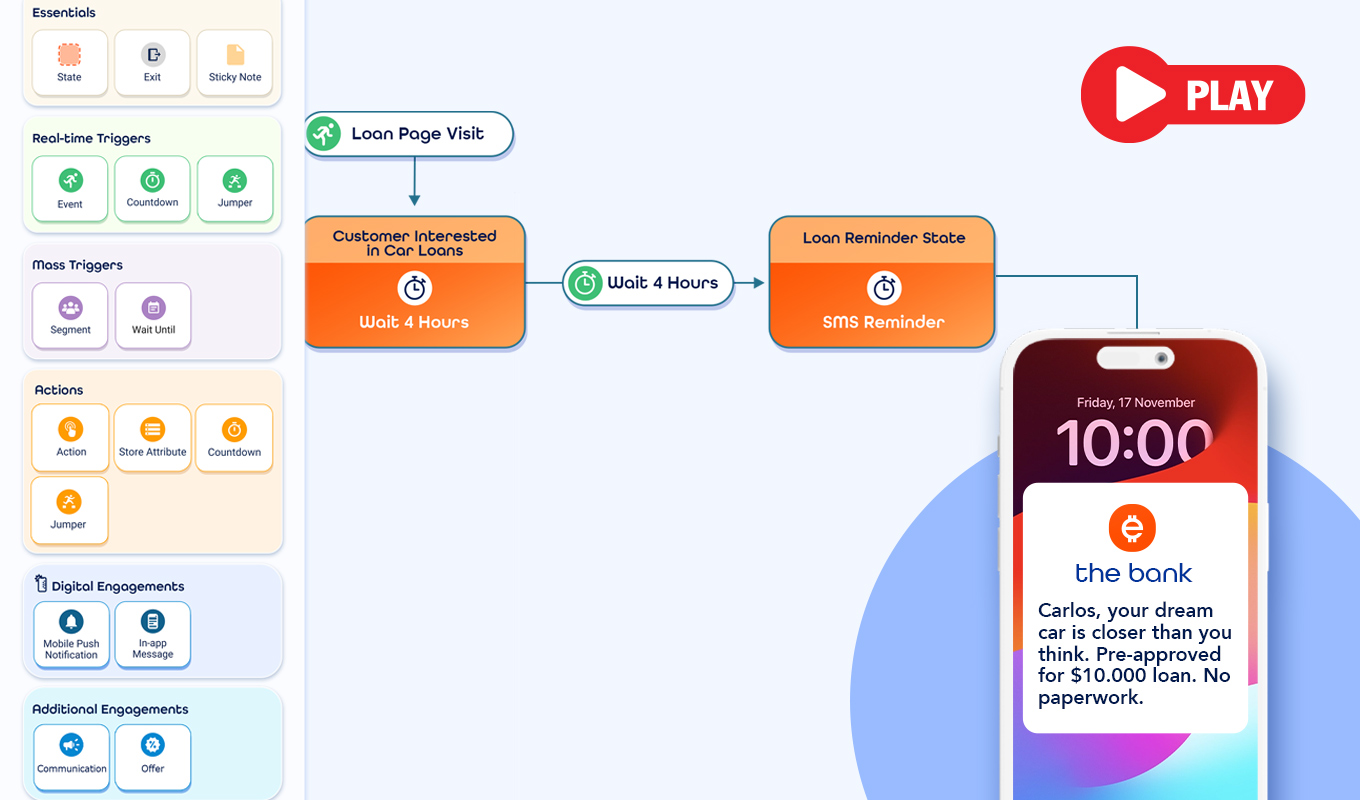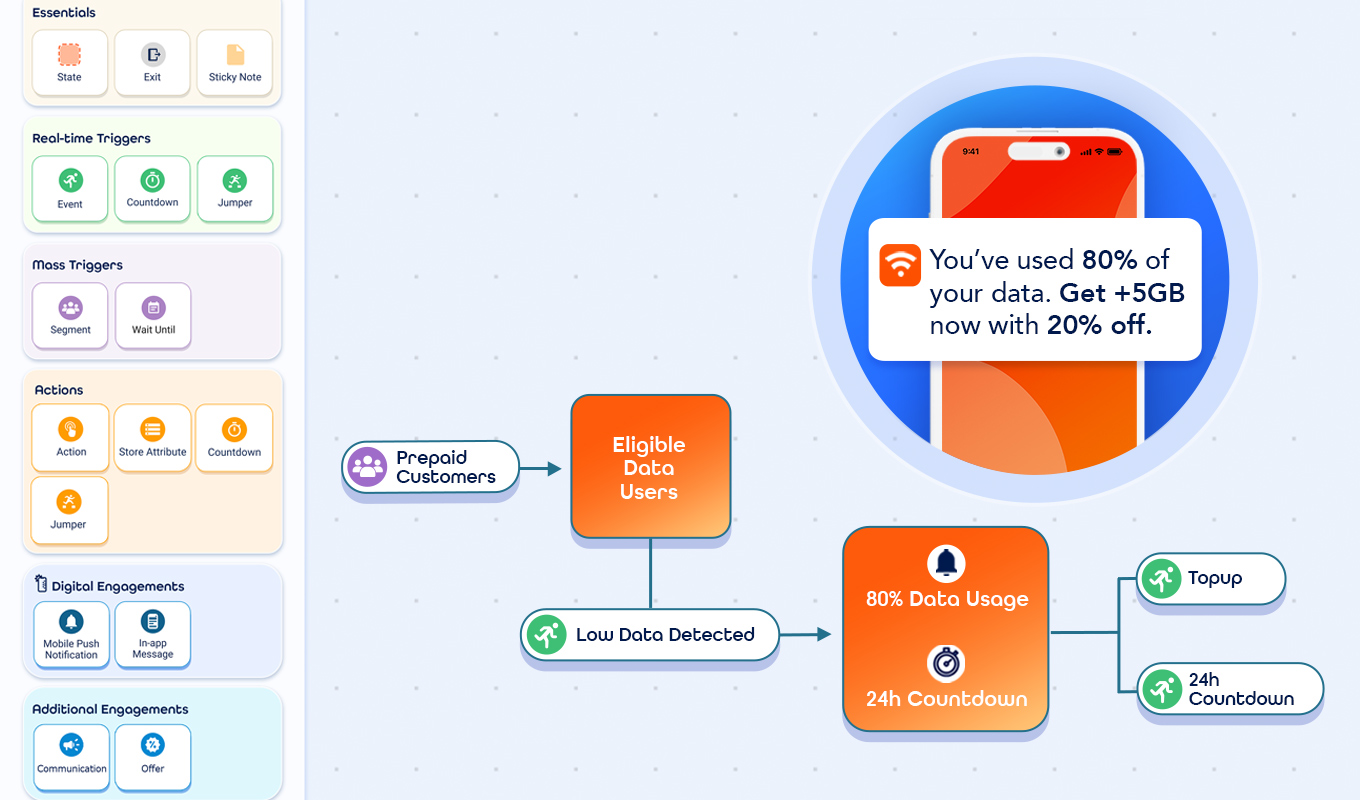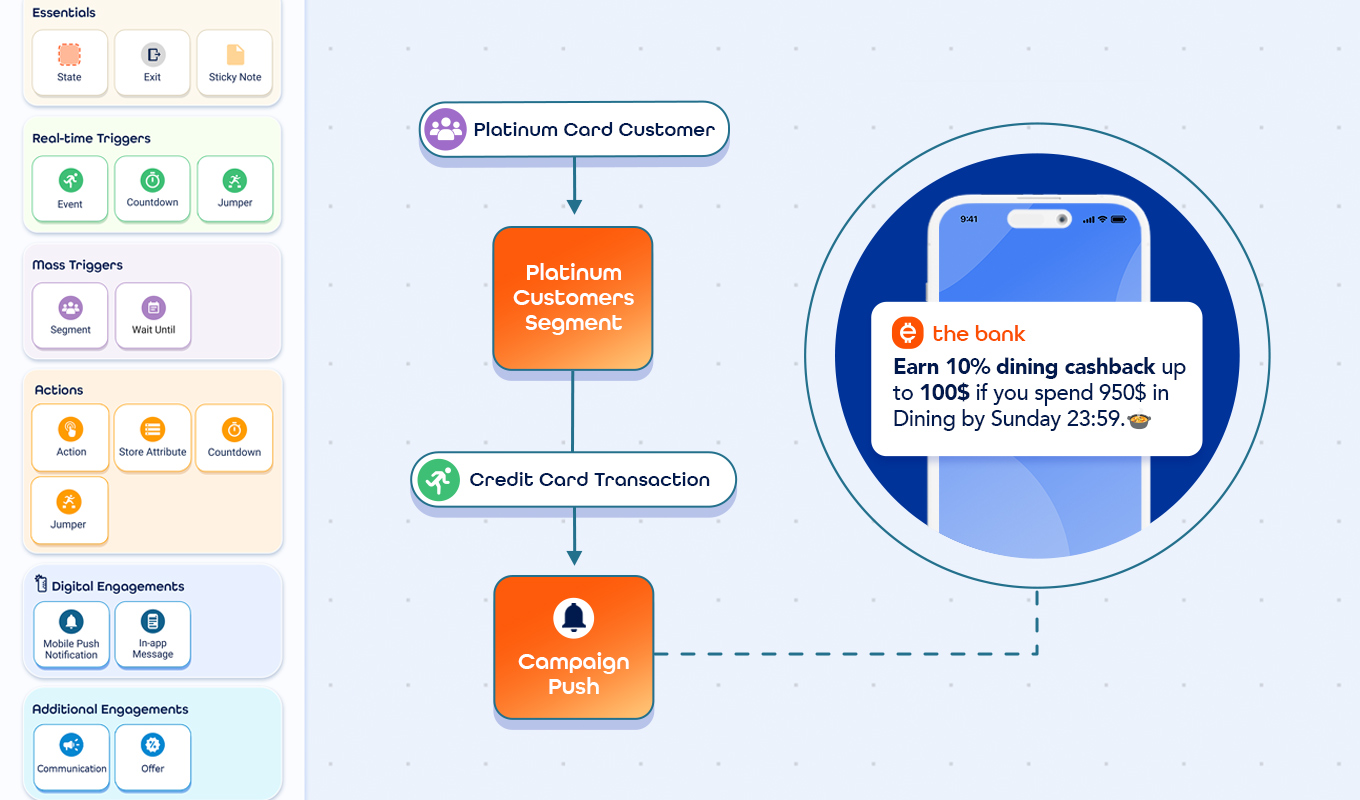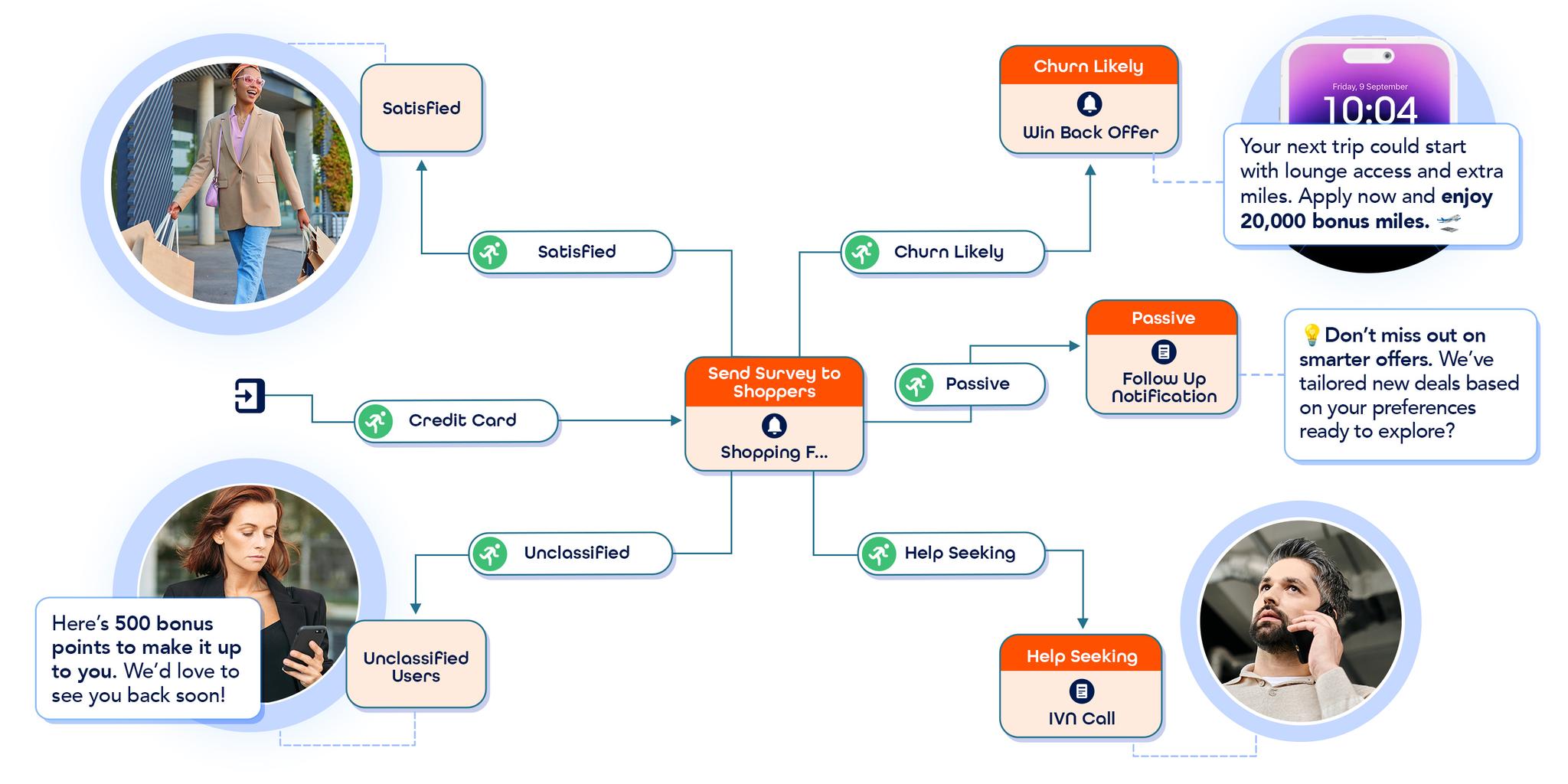- What Is a Customer Journey and Why It Matters
- Stages of the Customer Journey
- Key Digital Touchpoints Shaping Experiences
- The Power of Customer Journey Mapping
- Personalization Through Journey Mapping
- B2B vs. B2C Customer Journeys
- Orchestrating the Customer Journey with Technology
- Challenges in Journey Orchestration
- Real-Time Engagement as a Game Changer
- Personalization with Real-Time Data
- Implementing Real-Time Engagement Strategies
- evamX in Action: Real-Time Engagement at Scale
- Real-World Use Cases with evamX
- Frequently Asked Questions (FAQ)
A customer journey is the complete experience a customer has with your business, from their initial awareness to the final purchase and beyond. It encompasses every interaction they have with your brand, including visits to your website, social media engagement, and customer service interactions. Understanding the customer journey is essential for tailoring marketing efforts that resonate with your audience and foster long-term loyalty.
Stages of the Customer Journey
The customer journey is traditionally broken down into several stages: awareness, consideration, decision, and post-purchase. During the awareness stage, potential customers become conscious of a need or problem that your product or service can solve. This is the phase where first impressions count, and where effective marketing can capture attention.
In the consideration stage, potential customers evaluate different solutions. They compare options, read reviews, and seek recommendations. Your brand's ability to provide valuable information and demonstrate unique benefits can significantly influence their decision-making process.
The decision stage is where the customer chooses your product or service. This stage is critical for closing the sale and ensuring that the transaction process is smooth and satisfying.
Finally, the post-purchase stage involves ongoing engagement to build loyalty and encourage repeat business. Customer support and communication are key elements in nurturing long-term relationships.
Key Digital Touchpoints
Digital touchpoints are the various channels through which customers interact with your brand online. These can include your website, email marketing, social media platforms, and mobile apps. Each touchpoint offers an opportunity to influence the customer journey positively. Consistency across these platforms is crucial to creating a unified brand experience.
Websites are often the primary touchpoint, serving as the hub of information and interaction. Optimizing site design for user experience and ensuring mobile compatibility can enhance customer satisfaction.
Social media platforms provide a more informal setting for engagement, allowing brands to connect with audiences on a personal level through storytelling and community building.
Email marketing remains a powerful tool for nurturing leads and maintaining customer relationships. Personalized email campaigns that offer relevant content and exclusive offers can drive engagement and conversions.
Mobile apps provide another layer of convenience, offering users easy access to your products and services on-the-go.
The Power of Customer Journey Mapping
Mapping customer journeys involves visualizing the steps a customer takes when interacting with your brand. This process helps businesses understand customer needs and pain points at each stage. A well-mapped journey can reveal opportunities to improve customer experiences and eliminate friction points.
Effective journey mapping requires collecting and analyzing data from various sources, including customer feedback, analytics, and direct observations. By identifying patterns and trends, businesses can gain insights into customer behaviors and preferences. These insights can inform strategic decisions that enhance the overall journey.
Personalization Through Journey Mapping
Moreover, journey mapping allows companies to personalize experiences at scale. By understanding individual customer paths, businesses can tailor interactions to meet specific needs and expectations. This level of personalization can lead to higher customer satisfaction and increased loyalty.
To learn more about how unified customer data empowers real-time personalization at scale, see our post on leveraging unified customer profiles for smarter personalization.
B2B vs. B2C Customer Journeys
While both B2B and B2C customer journeys share similarities, they also have distinct differences. B2B journeys often involve longer sales cycles, multiple stakeholders, and more complex decision-making processes. Understanding these nuances is crucial for creating effective customer journey strategies tailored to each audience.
The Complexity of B2B Journeys
B2B customer journeys are inherently more complex due to the nature of business transactions. These journeys typically involve multiple decision-makers, each with their own priorities and concerns. This complexity requires a strategic approach that addresses the needs of all stakeholders involved.
The sales cycle in B2B journeys is generally longer, involving stages such as needs assessment, proposal development, and negotiation. Each stage requires careful planning and communication to ensure that all parties are aligned. Providing detailed information and demonstrating value are essential to moving prospects through the funnel.
Relationship-building is also a critical aspect of B2B journeys. Trust and credibility are paramount, as businesses seek partners who can deliver consistent value over time. Establishing strong relationships can lead to ongoing collaborations and referrals, which are vital for growth in the B2B sector.
The Emotional Nature of B2C Journeys
In contrast, B2C customer journeys often emphasize emotional appeal and convenience. Consumers in this sector tend to make decisions based on personal desires and emotional connections with brands. Therefore, B2C strategies focus on creating memorable and engaging experiences.
B2C journeys are typically shorter, with customers making quicker purchasing decisions. This requires businesses to capture attention swiftly and provide seamless paths to purchase. Visual storytelling and interactive content can enhance engagement and drive conversions.
Brand loyalty is a significant focus in B2C journeys. Creating positive emotional experiences can lead to repeat purchases and advocacy. Loyalty programs, personalized offers, and exceptional customer service are effective ways to build and maintain consumer loyalty.
Orchestrating the Customer Journey
Customer journey orchestration refers to the process of designing and managing the various touchpoints a customer encounters throughout their journey. By orchestrating these touchpoints, businesses can ensure a seamless and personalized experience for each customer. Effective orchestration requires a deep understanding of customer behavior and the ability to adapt strategies in real-time.
Technology plays a crucial role in customer journey orchestration. Advanced tools and platforms enable businesses to collect, analyze, and utilize data to optimize customer interactions. Automation and artificial intelligence (AI) are transforming the way businesses engage with customers, allowing for more efficient and personalized experiences.
Automation streamlines processes by managing repetitive tasks and triggering actions based on customer behavior. This ensures that customers receive timely and relevant communications, improving engagement and satisfaction. AI enhances personalization by analyzing vast amounts of data to predict customer needs and preferences.
Challenges in Journey Orchestration
Despite its benefits, orchestrating customer journeys presents challenges. One major challenge is the complexity of integrating multiple systems and data sources. Ensuring that all platforms communicate effectively requires careful planning and technical expertise.
Another challenge is maintaining consistency across channels. As customers interact with brands through various touchpoints, ensuring a cohesive experience becomes crucial. Inconsistencies can lead to confusion and dissatisfaction, undermining the overall journey.
Finally, privacy concerns pose a challenge in data-driven orchestration. Businesses must navigate regulations and ensure that customer data is handled securely and transparently. Building trust with customers is paramount, and respecting their privacy is a critical aspect of maintaining that trust.
Real-Time Engagement as a Game Changer
Real-time engagement is a key component of customer journey orchestration. By leveraging data and technology, businesses can respond to customer actions and preferences instantly. This capability allows companies to create dynamic and personalized experiences that meet the evolving needs of their customers.
Real-time data provides businesses with immediate insights into customer behavior and preferences. This information is invaluable for making informed decisions and adapting strategies on the fly. With real-time data, businesses can identify trends, anticipate needs, and deliver timely interventions.
For example, real-time data can help identify when a customer abandons their shopping cart. By triggering an automated response, such as a personalized email reminder or a targeted discount offer, businesses can encourage the completion of the purchase. This proactive approach can significantly reduce cart abandonment rates and increase sales.
Moreover, real-time data can enhance customer service by enabling instant support. Chatbots and live chat features can provide immediate assistance, resolving issues and answering queries in real-time. This level of responsiveness improves customer satisfaction and builds trust in the brand.
For further strategies on how real‑time data powers seamless engagement across channels, check out our deep dive into real‑time customer experience optimization.
Personalization with Real-Time Data
Personalization is a cornerstone of effective real-time engagement. By leveraging real-time data, businesses can deliver personalized experiences that resonate with individual customers. This involves tailoring content, offers, and interactions to align with customer preferences and behaviors.
Dynamic content is a powerful tool for personalization. It allows businesses to present different messages or visuals based on real-time customer data. For instance, a returning visitor to a website might see personalized product recommendations based on their previous browsing history. This targeted approach enhances the relevance of the content and increases the likelihood of conversion.
Real-time engagement also enables personalized communication. Businesses can send targeted messages through various channels, such as push notifications, emails, or SMS, based on real-time triggers. These messages can be tailored to the customer's current context, increasing their impact and effectiveness.
Implementing Real-Time Engagement
Implementing real-time engagement strategies requires careful planning and execution. Businesses need to invest in the right technologies and tools to collect and analyze real-time data effectively. This includes implementing robust data analytics platforms and integrating them with existing systems.
Training and empowering staff to leverage real-time data is also crucial. Employees need to understand how to interpret data insights and translate them into actionable strategies. This requires ongoing education and collaboration across departments to ensure alignment and consistency.
Finally, businesses must continually evaluate and optimize their real-time engagement strategies. This involves monitoring performance metrics, gathering customer feedback, and making data-driven adjustments. By staying agile and responsive, businesses can maintain a competitive edge and deliver exceptional customer experiences.
evamX in Action: Real-Time Engagement at Scale
evamX is our next-generation platform that transforms customer journey orchestration into measurable business impact. By combining AI-powered intelligence, omnichannel orchestration, and real-time personalization, evamX helps businesses engage customers at the right moment, on the right channel, with the right message.
What Makes evamX Unique
✨ Visual Journey Designer: Drag-and-drop orchestration with triggers, conditions, and actions for fast, intuitive design of complex journeys.
🤖 AI-Powered Engagement: Features like Message Genius for instant content creation, Sense AI for intent and sentiment analysis, and Summarizer AI for instant clarity of journeys and segments.
📲 Multi-Channel Digital Engagement: Push, in-app messaging, web push, and banners — all personalized with dynamic data, AI-driven copy, and real-time conversion tracking.
📊 Insights & Reporting: Dashboards for journey performance, push/in-app effectiveness, heatmaps, and NPS tracking, enabling data-driven optimization.
🗣️ Customer Feedback: Integrated survey creation, delivery, and monitoring across channels for real-time insights into satisfaction and NPS.
Real-World Use Cases with evamX
Banking: Preventing Abandonment and Driving Conversions
The Challenge:
A leading retail bank noticed that many customers began online loan applications but never completed them. Traditional reminders were too slow and generic, causing lost revenue and poor customer experience.
The evamX Solution:
With evamX, the bank created a real-time journey that detects when an application is abandoned. Within minutes, customers receive a personalized push or email with a one-click deep link to continue the process. If they don’t act within 24 hours, evamX triggers a follow-up SMS with a limited-time incentive to finish the application.
The Impact:
📈 Loan completion rates increased by 27%
😊 Customer frustration decreased thanks to timely, helpful reminders.
🤝 The bank built trust by showing attentiveness at a critical moment.
Watch our demo and see how evamX re-engages customers instantly to recover revenue.

Telecom: Proactive Upsell Before Frustration Hits
The Challenge:
A telecom operator faced high churn from “bill shock.” Customers would run out of data unexpectedly, leading to complaints and cancellations.
The evamX Solution:
evamX monitors data usage in real time. When a subscriber approaches 80% of their monthly limit, the platform automatically triggers a personalized in-app message or SMS. Heavy video users receive larger package offers, while light users see affordable add-ons. AI-driven content ensures the right tone and context.
The Impact:
📉 Churn dropped significantly as customers felt in control.
💰 Data top-up revenue increased.
🙌 Customers perceived the brand as proactive and supportive, not reactive.
Click and explore how evamX predicts customer needs and delivers upsell offers before dissatisfaction sets in.

Retail: Turning Browsing Into Buying
The Challenge:
An e-commerce retailer saw thousands of abandoned carts daily. Shoppers would browse and even add items but rarely completed purchases, hurting conversion rates.
The evamX Solution:
evamX designed a multi-step recovery journey. If a cart is abandoned, the customer immediately receives a push notification with a reminder. If ignored, a personalized email follows with product recommendations or a small discount. On returning to the site, customers see dynamic web banners tailored to their browsing history — from “complete your purchase” nudges to bundle offers.
The Impact:
🛒 Cart abandonment dropped by 35%.
📦 Average basket size increased with bundled offers.
🌟 Customer satisfaction rose thanks to hyper-relevant engagement.
Click and experience how evamX transforms hesitation into completed purchases with real-time triggers.

Frequently Asked Questions (FAQ)
1. What is a customer journey, and why is it important?
A customer journey is the complete experience a customer has with your business — from the first moment of awareness to post-purchase engagement. Mapping and understanding this journey helps brands deliver personalized, consistent interactions that improve satisfaction, loyalty, and revenue.
2. How should businesses think about the stages of the customer journey?
Instead of viewing the journey as a single transaction, it’s best understood as a continuous relationship. Customers move from discovering a brand, to evaluating it, to making a decision, and eventually to engaging after purchase. Each stage shapes their overall perception, and businesses that guide customers seamlessly through these phases create stronger loyalty and long-term value.
3. How do digital touchpoints affect the customer journey?
Digital touchpoints — such as websites, mobile apps, social media, and email — shape how customers interact with your brand. Consistency across these channels is essential for building trust and delivering a seamless experience.
4. What is customer journey orchestration?
Customer journey orchestration is the process of designing and managing all interactions across different touchpoints. With tools like automation and AI, businesses can coordinate these interactions in real time, ensuring customers receive relevant and personalized experiences at the right moment.
5. Why is real-time engagement a game changer?
Real-time engagement allows businesses to act on customer behavior instantly. For example, if a shopper abandons their cart, they can receive a personalized reminder or discount within minutes. This immediacy boosts conversions, reduces churn, and strengthens customer relationships.
6. What role does personalization play in customer engagement?
Personalization tailors content, offers, and interactions to individual customer needs. By using real-time data, businesses can deliver highly relevant messages — whether it’s a product recommendation, a push notification, or a dynamic web banner — that drive stronger results.
7. What is evamX, and how does it support real-time engagement?
evamX is an advanced customer engagement platform that combines journey orchestration, AI-driven personalization, and omnichannel execution. It enables businesses to design seamless customer journeys, trigger personalized interactions, and optimize engagement through detailed insights.
8. How does evamX leverage AI?
evamX includes features like Message Genius (AI-powered content creation), Sense AI (sentiment and intent analysis), and Summarizer AI (automated journey and segment summaries). These tools make personalization and orchestration faster, smarter, and more impactful.
9. How can businesses get started with real-time engagement strategies?
Start by mapping customer journeys, identifying key digital touchpoints, and investing in platforms like evamX that unify data, automation, and AI. Then, continuously test, monitor, and optimize engagement strategies to ensure they meet evolving customer expectations.








